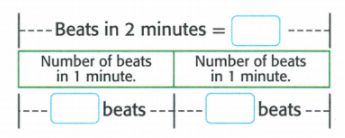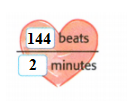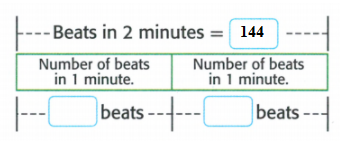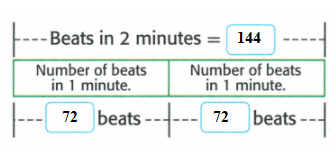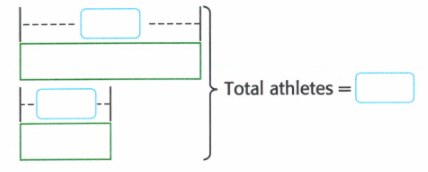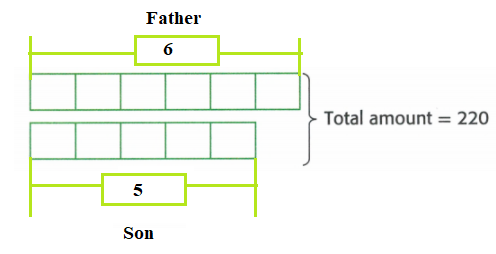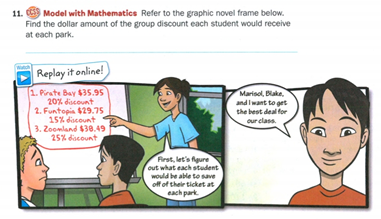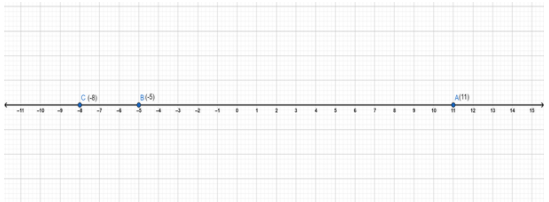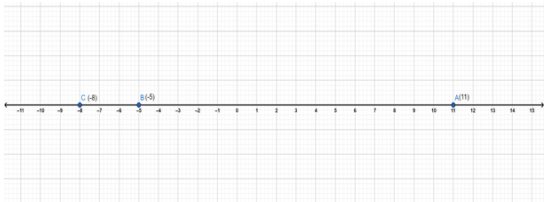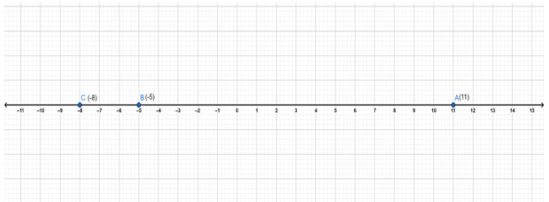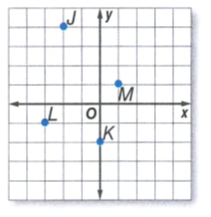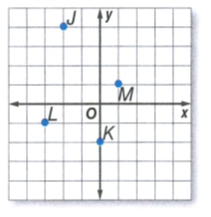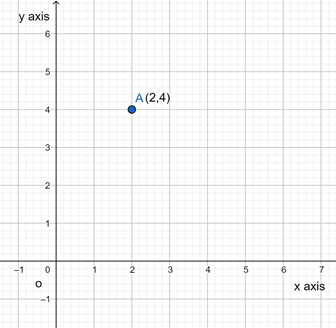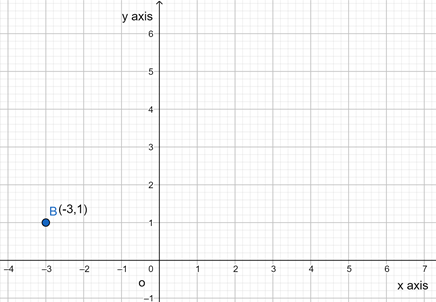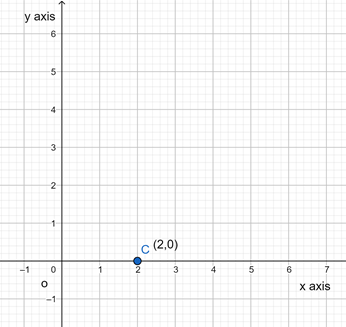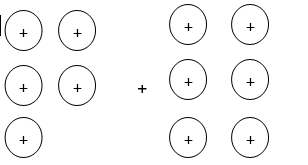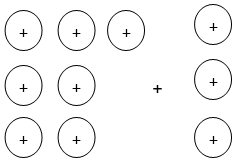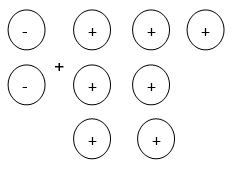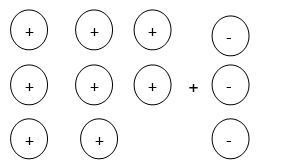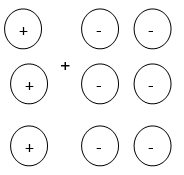Glencoe Math Course 2 Volume 1 Common Core Chapter 1 Ratios and Proportional Reasoning
Page 33 Exercise 1 Problem 1
Let the two ratios be a:b and c:d
If both the ratios are equal a:b=c:d
Then the given ratio is said to be in proportion.
Furthermore, if the sets fluctuate in the same proportion, the ratio is indeed in proportion.
In terms of objects, if two objects have the same form but different sizes, they are perhaps the same shape but different sizes.
For instance, suppose the two objects are spheres, but one is smaller and the other is larger.
Despite the fact that the sizes differ, the corresponding angles would be the same.
As a result, their ratios are proportional.
As a result, the two objects are proportional.
When two objects have the same form, and same angles, but various sizes, they all seem to be in proportion.
As a result, their ratios are proportional.
Page 36 Exercise 1 Problem 2
The Vista Marina rents boats for $25 per hour.
In addition to the rental fee, there is a $12 charge for fuel.
We need to determine whether the number of hours you can rent the boat is proportional to the total cost.
As per the given information

For each hour, the relationship between the cost and the rental time as a ratio in its simplest form will be,
\(\frac{\text { cost }}{\text { Time }}=\frac{37}{1}\) = 37
\(\frac{62}{2}\) = 31
\(\frac{87}{3}\) = 29
The ratios of the two quantities are not the same.
Therefore, the number of hours you can rent the boat is not proportional to the total cost
The number of hours you can rent the boat is not proportional to the total cost.
Page 36 Exercise 2 Problem 3
We need to find out which situation represents a proportional relationship between the hours worked and the amount earned for Matt and Jane.
The given is

The given is

For each hour, the relationship between the time and Matt’s earnings as a ratio in its simplest form will be
\(\frac{\text {Earning}}{\text { Time }}=\frac{12}{1}\) = 12
\(\frac{20}{2}\) = 10
\(\frac{31}{3}\) = 10.33
The values of the ratios are different. Thus, they are not proportional.
Similarly
For each hour, the relationship between the time and Jane’s earnings as a ratio in its simplest form will be
\(\frac{12}{1}\) = 12
\(\frac{24}{2}\) = 12
\(\frac{36}{3}\) = 12
The ratios of the two quantities are the same. Therefore, they are proportional.
Jane’s situation represents a proportional relationship between the hours worked and a mount earned.
Page 37 Exercise 1 Problem 4
Given that, an adult elephant drinks about 225 liters of water each day.
We need to determine whether the number of days the water supply lasts is proportional to the number of liters of water the elephant drinks or not.
For each day, the elephant drinks 225 L of water.
As per the given information, completing the table as below

For each day, the relationship between the number of days and the number of liters of water the elephant drinks as a ratio in its simplest form will be
\(\frac{225}{1}\) = 225
\(\frac{450}{2}\) = 225
\(\frac{675}{3}\) = 225
\(\frac{900}{4}\) = 225
The ratios of the two quantities are the same.
Therefore, the number of days the water supply lasts is proportional to the number of liters of water the elephant drinks.
The number of days the water supply lasts is proportional to the number of liters of water the elephant drinks.
Page 37 Exercise 2 Problem 5
Given that an elevator ascends, or goes up, at a rate of 750 feet per minute.

We need to determine whether the height to which the elevator ascends is proportional or not to the number of minutes it takes to get there.
For each minute, the elevator rises 750 feet.
As per the given information, completing the table as below

For each minute, the relationship between the height and the time as a ratio in its simplest form will be
\(\frac{750}{1}\) = 750
\(\frac{1500}{2}\) = 750
\(\frac{2250}{3}\) = 750
\(\frac{3000}{4}\) = 750
The ratios of the two quantities are the same.
Therefore, the height to which the elevator ascends is proportional to the number of minutes it takes to get there.
The height to which the elevator ascends is proportional to the number of minutes it takes to get there.
Page 37 Exercise 3 Problem 6
We need to determine which among the given situation represents a proportional relationship between the number of laps run by each student and their time

The given table is

For each second, the relationship between the laps and Desmond’s time as a ratio in its simplest form will be,
\(\frac{146}{2}\) = 73
\(\frac{292}{4}\) = 73
\(\frac{584}{8}\) = 73
The ratios of the two quantities are the same.
Therefore, the number of laps is proportional to Desmond’s time.
For each second, the relationship between the laps and Maria’s time as a ratio in its simplest form will be,
\(\frac{150}{2}\)= 75
\(\frac{320}{4}\) = 80
\(\frac{580}{6}\) = 96.67
The ratios of the two quantities are not the same.
Therefore, the number of laps is not proportional to Maria’s time.
Desmond’s situation represents a proportional relationship between the number of laps run by him and their time.
Page 37 Exercise 4 Problem 7
Given that, Plant A is 18 inches tall after one week, 36 inches tall after two weeks, and 56 inches tall after three weeks.
Plant B is 18 inches tall after one week, 36 inches tall after two weeks, and 54 inches tall after three weeks.
We need to determine which situation represents a proportional relationship between the plants’ height and the number of weeks.
From the given information, forming a table with those values

Also

The ratio in its simplest form for Plant A is
\(\frac{18}{1}\) = 18
\(\frac{36}{2}\) = 18
\(\frac{56}{3}\) = 18.67
The ratios of the two quantities are not the same.
Therefore, the plant’s height is not proportional to the number of weeks.
Similarly, The ratio in its simplest form for Plant B is
\(\frac{18}{1}\) = 18
\(\frac{36}{2}\) = 18
\(\frac{54}{3}\) = 18
The ratios of the two quantities are the same.
Therefore, the plant B’s height is proportional to the number of weeks.
Plant B’s situation represents a proportional relationship between the plants’ height and number of weeks.
Page 38 Exercise 7 Problem 8
Given that, Blake ran laps around the gym. His times are shown in the table below.

Blake is trying to decide whether the number of laps is proportional to the time. We need to find his mistake and correct it.
As per the given information

We need to determine whether the number of laps is proportional to the time.
The relationship between the number of laps and the time as a ratio in its simplest form will b
\(\frac{4}{1}\) = 4
\(\frac{6}{2}\) = 3
\(\frac{8}{3}\) = 2.67
\(\frac{10}{4}\) = 2.5
The ratios of the two quantities are not the same.
Therefore, the number of laps is not proportional to the time.
The number of laps is not proportional to the time.
Page 38 Exercise 8 Problem 9
We need to determine whether the cost for ordering multiple items that will be delivered is sometimes, always, or never proportional.
Also, we need to explain it.
Consider the price of an item, here we have considered a pen drive which costs $10.
If we ordered 10 pen drives, the cost will be
10 dollars × 10 = 100 dollars
If we ordered 20
20 × 10 = 200 dollars
For 30 pen drives
30 × 10 = 300 dollars
The relationship between the number of units and the cost as a ratio in its simplest form will be,
\(\frac{100}{10}\) = 10
\(\frac{200}{20}\) = 10
\(\frac{300}{30}\) = 10
Thus, the ratios are the same.
Thus, the cost for ordering multiple items that will be delivered is always proportional.
The cost for ordering multiple items that will be delivered is always proportional.
Page 38 Exercise 9 Problem 10
We need to determine which of the given relationship has a unit rate of 60 miles per hour.
Calculating the unit rate one by one
1) 300 miles in 6 hours
Unit rate \( = \frac{\text { Number of miles }}{\text { Number of hours }}\)
= \(\frac{300}{6}\)
= 50 miles/ hour
Unit rate= 50 miles/hour
2) 300 miles in 5 hours
Unite rate = \(\frac{300}{5}\)
Unit rate = 60 miles/hour
3) 240 miles in 6 hours
Unite rate = \(\frac{240}{6}\)
Unit rate = 40 miles/hour
4) 240 miles in 5 hours
Unit rate = \(\frac{240}{5}\)
Unit rate = 48 miles/hour
300 Miles in 5 hours have a unit rate of 60 miles per hour.
Page 39 Exercise 10 Problem 11
Given that a vine grows 7.5 feet every 5 days.
We need to determine whether the length of the vine on the last day is proportional to the number of days of growth.

The given table is

We need to determine whether the length of the vine on the last day is proportional to the number of days of growth.
The relationship between the time and the length as a ratio in its simplest form will be,
\(\frac{7.5}{5}\) = 1.5
\(\frac{15}{10}\) = 1.5
\(\frac{22.5}{15}\) = 1.5
\(\frac{30}{20}\) = 1.5
The ratios of the two quantities are the same.
Therefore, the length of the vine on the last day is proportional to the number of days of growth.
The length of the vine on the last day is proportional to the number of days of growth
Page 39 Exercise 11 Problem 12
Given that, To convert a temperature in degrees Celsius to degrees Fahrenheit, multiply the Celsius temperature by \(\frac{9}{5}\)and then add 32 degrees
We need to determine whether the temperature in degrees Celsius is proportional to its equivalent temperature in degrees Fahrenheit.
As per the given information, the completed table will be
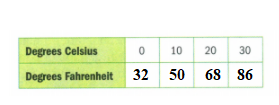
We need to determine whether the temperature in degrees Celsius is proportional to its equivalent temperature in degrees Fahrenheit.
The relationship between the Celsius and the Fahrenheit as a ratio in its simplest form will be
\(\frac{0}{32}\) = 0
\(\frac{10}{50}\) = \(\frac{1}{5}\) = 0.2
\(\frac{20}{68}\) = 0.294
\(\frac{30}{86}\) = 0.3488
The ratios of the two quantities are not the same.
Therefore, the temperature in degrees Celsius is not proportional to its equivalent temperature in degrees Fahrenheit.
The temperature in degrees Celsius is not proportional to its equivalent temperature in degrees Fahrenheit.
Page 40 Exercise 14 Problem 13
Given that, Mr. Martinez is comparing the price of oranges from several different markets.
We need to determine which market’s pricing guide is based on a constant unit price
Determine whether the total cost and the number of oranges are proportional or not.

1) \(\frac{3.50}{5}\) = 0.7
\(\frac{6}{10}\) = 0.6
\(\frac{8.50}{15}\) = 0.5667
\(\frac{11}{20}\) = 0.55
The ratio values are different.
2) \(\frac{3.50}{5}\) = 0.7
\(\frac{6.50}{10}\) = 0.65
\(\frac{9.50}{15}\) = 0.633
\(\frac{12.50}{20}\) = 0.467
The ratio values are different.
3) \(\frac{3}{5}\) = 0.6
\(\frac{5}{10}\) = 0.5
\(\frac{7}{15}\) = 0.467
\(\frac{9}{20}\) = 0.45
The ratio values are different.
4) \(\frac{3}{5}\) = 0.6
\(\frac{6}{10}\) = 0.6
\(\frac{9}{15}\) = 0.6
\(\frac{12}{20}\) = 0.6
The ratio values are the same.
Hence, Option (4) is the market’s pricing guide is based on a constant unit price.
Option (4) is the market’s pricing guide is based on a constant unit price.
Page 40 Exercise 15 Problem 14
Given that, the middle school is planning a family movie night where popcorn will be served.
The constant relationship between the number of people n and the number of cups of popcorn p is shown in the table.
We need to determine how many people can be served with 519 cups of popcorn.

Given that the relationship between the number of people and the number of cups of popcorn is constant.
Using the proportionality relationship
Let x be the number of people who can be served with 519 cups of popcorn.
\(\frac{30}{90}\) = \(\frac{x}{519}\)
\(\frac{1}{3}\)= \(\frac{x}{519}\)
x = \(\frac{519}{3}\)
x = 173
173 people can be served with 519 cups of popcorn.
Page 40 Exercise 16 Problem 15
Given that, x = 12
We need to find the value of 3x
The given expression is 3x
Also x = 12
Thus, the value becomes
3x = 3 (12)
3x = 36
The value of 3x = 36
Page 40 Exercise 17 Problem 16
Given that, x = 12
We need to find the value of 2x − 4
The given expression is 2x − 4
Also x = 12
Thus, the value becomes
2x − 4 = 2(12) − 4
2x − 4 = 24 − 4
2x − 4 = 20
The value of 2x − 4 = 20
Page 40 Exercise 18 Problem 17
Given that, x = 12
We need to find the value of 5x + 30
The given expression is 5x + 30
Also x = 12
Thus, the value becomes
5x + 30 = 5(12) + 30
5x + 30 = 60 + 30
5x + 30 = 90
The value of 5x + 30 = 90
Page 40 Exercise 19 Problem 18
Given that, x = 12
We need to find the value of 3x − 2x
The given expression is 3x − 2x
Also x = 12
Thus, the value becomes
3x − 2x = 3(12) − 2(12)
3x − 2x = 36 − 24
3x − 2x = 12
The value of 3x − 2x = 12
Page 40 Exercise 22 Problem 19
Given that, Brianna downloads 9 songs each month onto her MP3 player.
We need to show the total number of songs downloaded after 1,2,3, and 4 months.

For the first month, the number of songs downloaded is 9.
For the second month
9 × 2 = 18 songs
For the third month
9 × 3 = 27 songs
For the fourth month
9 × 4 = 36 songs
Thus, the table becomes

The total number of songs downloaded after 1,2,3, and 4 months is shown below

Page 44 Exercise 1 Problem 20
We need to define complex fractions and also give two examples of complex fractions.
A complex fraction is nothing but a fraction that has fractions in its denominator or in the numerator or in both.
For example
\(\frac{5}{\frac{12}{3}}, \frac{\frac{10}{15}}{25}, \frac{\frac{14}{8}}{\frac{8}{5}}\) These are all complex fractions.
Solving a complex fraction:
Let us consider a complex fraction \(\frac{5}{\frac{12}{3}}\)
Simplifying it, we get
\(\frac{5}{\frac{12}{3}}\)= \(\frac{5}{2}\)× \(\frac{1}{10}\)
= \(\frac{1}{2}\)×\(\frac{1}{2}\)
= \(\frac{1}{4}\)
A complex fraction is a fraction that has more than one fraction.
That is, fractions will be in their denominator or in the numerator, or in both.
The two examples of complex fractions are \(\frac{11}{\frac{9}{7}} \text { and } \frac{\frac{22}{8}}{\frac{6}{7}}\)
Page 44 Exercise 2 Problem 21
A rate is a fraction of a ratio of two different quantities.
A ratio differs from a rate as the ratio is the relationship between two quantities of the same or different units.
The rate only deals with different units.
When we simplify a rate to make their denominator as 1, then it is said to be the unit rate.
Unit rate is nothing but the rate per unit of a quantity.
For example, if we buy 8 flowers for $10.
The unit rate is the cost of 1 flower.
When a rate is simplified so that it has a denominator of 1 unit, it is called a unit rate.
Page 44 Exercise 3 Problem 22
Given that, 750 yards in 25 minutes.
We need to determine the unit rate of the given and round the unit rate obtained to the nearest hundredth if needed.
Number of yards = 750
Number of minutes = 25
The unit rate is given by
Unite rate \(=\frac{\text { Number of yards }}{\text { Number of minutes }}\)
= \(\frac{750}{25}\)
= 30 yards per minute
The unit rate of the given is 30 yards per minute.
Page 44 Exercise 4 Problem 24
Given that, $420 for 15 tickets.
We need to determine the unit rate of the given and round the unit rate obtained to the nearest hundredth if needed.
Amount in dollars = $420
Number of tickets = 15
The unit rate is
Unite rate \(=\frac{\text { Amount in dollars }}{\text { Number of tickets }}\)
= \(\frac{420}{15}\)
= 28 dollars per ticket
The unit rate of giving is, 28 dollars per ticket
Page 44 Exercise 5 Problem 25
Given, the complex fraction is\(\frac{9}{\frac{1}{3}}\)
We need to simplify the given complex fraction.
Rewrite the given fraction as a division.
The expression becomes
\(\frac{9}{\frac{1}{3}}\) = \(\frac{9}{1}\) ÷ \(\frac{1}{3}\)
Multiply it by the reciprocal of \(\frac{1}{3}\) , we get
\(\frac{9}{\frac{1}{3}}\) = \(\frac{9}{1}\) ÷ \(\frac{1}{3}\)
\(\frac{9}{\frac{1}{3}}\) = \(\frac{9}{1}\) × \(\frac{1}{3}\)
Simplifying it further, we get
\(\frac{9}{\frac{1}{3}}\) = \(\frac{9}{1}\) × \(\frac{1}{3}\)
= \(\frac{27}{1}\)
= 27
The value of \(\frac{9}{\frac{1}{3}}\) is equal to 27.
Page 44 Exercise 7 Problem 26
Given, the complex fraction is \(\frac{\frac{1}{6}}{1 \frac{3}{8}}\)
We need to simplify the given complex fraction.
Rewrite the given fraction as a division.
The expression becomes
\(\frac{\frac{1}{6}}{1 \frac{3}{8}}=\frac{1}{6} \div 1 \frac{3}{8}\)\(\frac{\frac{1}{6}}{1 \frac{3}{8}}=\frac{1}{6} \div \frac{11}{8}\)
Multiply it by the reciprocal of \(\frac{11}{8}\) , we get
\(\frac{\frac{1}{6}}{1 \frac{3}{8}}=\frac{1}{6} \div \frac{11}{8}\)
\(\frac{\frac{1}{6}}{1 \frac{3}{8}}\)= \(\frac{1}{6}\) × \(\frac{8}{11}\)
Simplifying it further, we get
\(\frac{\frac{1}{6}}{1 \frac{3}{8}}\)= \(\frac{1}{6}\) × \(\frac{8}{11}\)
= \(\frac{1}{3}\)×\(\frac{4}{11}\)
= \(\frac{4}{33}\)
The value of \(\frac{\frac{1}{6}}{1 \frac{3}{8}}\) is equal to \(\frac{4}{33}\)
Page 44 Exercise 9 Problem 27
We need to find out which among the given is the same as 2,088 feet per minute.
(1) 696 Meters per minute
(2) 696 Yards per minute
(3) 696 Feet per minute
(4) 696 Yards per second
Convert the given, 2,088 feet per minute to meters per minute.
Converting we get \(\frac{2088 \text { feet }}{1 \text { minute }}=\frac{2088 \text { feet }}{1 \text { minute }} \times \frac{0.3048 \text { meters }}{1 \text { feet }}\)
= \(\frac{2088 \times 0.3048 \text { meters }}{1 \text { minute }}\)
= 636.42 meters per minute
Convert the given to yards per minute \(\frac{2088 \text { feet }}{1 \text { minute }}=\frac{2088 \text { feet }}{1 \text { minute }} \times \frac{0.3333 \text { yards }}{1 \text { feet }}\)
= \(\frac{2088 \times 0.3333 \text { yards }}{1 \text { minute }}\)
= 696 yards per minute
Thus. Option (2) is correct.
696 yards per minute is the same as 2,088 feet per minute.

